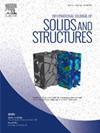团聚和波状现象对 MWCNT 增强复合材料棒扭转振荡的影响
IF 3.4
3区 工程技术
Q1 MECHANICS
International Journal of Solids and Structures
Pub Date : 2024-11-02
DOI:10.1016/j.ijsolstr.2024.113127
引用次数: 0
摘要
在制造增强复合材料结构的过程中,不可避免地会遇到一些挑战。钢筋聚集和波浪形钢筋就是其中之一。这些现象对增强复合材料结构的力学行为有着显著的影响。在当前的研究中,我们评估了多壁碳纳米管(MWCNTs)增强复合材料棒在两种不同的边界条件下,增强体的聚集和波浪状对其扭转动态特性的影响。为了了解横截面形状对 MWCNTs 增强复合材料杆扭转行为的影响,我们考虑了三种不同的横截面形状。采用了一种新形式的 Halpin-Tsai 均质化模型来估算复合材料结构的材料特性。此外,Timoshenko-Gere 理论与汉密尔顿原理相结合,推导出了 MWCNTs 增强复合材料杆的偏微分控制方程。随后,利用分析方法求解了所得方程。所使用方法的精确度已根据文献中记录的先前研究结果进行了评估。最后,分析了各种重要参数对自然扭转频率变化的影响,并通过一系列表格和图表进行了展示。根据所获得的结果,矩形杆的扭转频率最高,同时,MWCNTs 体积分数的影响取决于对波浪度和聚结因素的考虑。当 MWCNT 的体积分数越大时,聚结因子比波状因子更有效,反之亦然。本文章由计算机程序翻译,如有差异,请以英文原文为准。
Influence of agglomeration and waviness phenomena on torsional oscillation of MWCNTs-reinforced composite rods
There are some inevitable challenges during the manufacturing of reinforced composite structures. Agglomeration of reinforcement and wavy reinforcement are in this category. These phenomena possess remarkable effects on the mechanical behavior of reinforced composite structures. In the current research, the effect of agglomeration and waviness of reinforcements on torsional dynamic characteristics of multi-walled carbon nanotubes (MWCNTs) reinforced composite rods subjected to two various boundary conditions have been evaluated. Three dissimilar cross-section shapes have been considered to understand the effect of cross-section shapes on torsional behavior of MWCNTs-reinforced composite rods. A new form of Halpin-Tsai homogenization model has been exerted to estimate the material properties of composite structures. Additionally, Timoshenko-Gere theory in conjunction with the Hamilton’s principle has been employed to derive the partial differential governing equation of MWCNTs-reinforced composite rods. Afterward, the obtained equation was solved using an analytical approach. The precision of the methodology utilized has been evaluated against the results of previous studies documented in the literature. Ultimately, the effects of various significant parameters on the changes in natural torsional frequency have been analyzed and presented in a series of tables and figures. Based on the obtained results, the rectangular rod has the highest torsional frequency and also the effect of MWCNTs’ volume fraction depends on the consideration of waviness and agglomeration factors. At a greater volume fraction of MWCNTs, the agglomeration factor is more effective than the waviness factor and vice versa.
求助全文
通过发布文献求助,成功后即可免费获取论文全文。
去求助
来源期刊
CiteScore
6.70
自引率
8.30%
发文量
405
审稿时长
70 days
期刊介绍:
The International Journal of Solids and Structures has as its objective the publication and dissemination of original research in Mechanics of Solids and Structures as a field of Applied Science and Engineering. It fosters thus the exchange of ideas among workers in different parts of the world and also among workers who emphasize different aspects of the foundations and applications of the field.
Standing as it does at the cross-roads of Materials Science, Life Sciences, Mathematics, Physics and Engineering Design, the Mechanics of Solids and Structures is experiencing considerable growth as a result of recent technological advances. The Journal, by providing an international medium of communication, is encouraging this growth and is encompassing all aspects of the field from the more classical problems of structural analysis to mechanics of solids continually interacting with other media and including fracture, flow, wave propagation, heat transfer, thermal effects in solids, optimum design methods, model analysis, structural topology and numerical techniques. Interest extends to both inorganic and organic solids and structures.

 求助内容:
求助内容: 应助结果提醒方式:
应助结果提醒方式:


